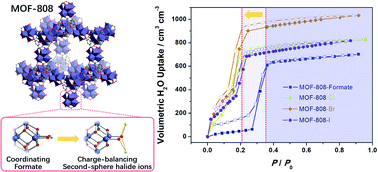Incorporation of free halide ions stabilizes metal–organic frameworks (MOFs) against pore collapse and renders large-pore Zr-MOFs functional for water harvesting†
Abstract
Chemically and hydrolytically stable MOFs have shown promising water-vapor adsorption properties. However, MOFs that can simultaneously satisfy the following three requirements for effective water harvesting from low-humidity air are quite rare: (1) high water-uptake capacity; (2) hydrolytic and mechanical stability; (3) complete uptake at ∼20–30% relative humidity (RH). Here we show that incorporating free halide ions is effective for enabling a representative Zr-MOF to meet these requirements for water harvesting. As-synthesized MOF-808 initially exhibits very good capacity at RH ≥ 30%, but quickly suffers large capacity losses due to water-evacuation-induced pore collapse. Via a framework-charging and free counter-ion inclusion approach, we were able to replace node-ligated formate anions with charge-neutral aqua ligands and site desired water-sorbing free-halide ions within the large pores of MOF-808. Altered samples show increased gravimetric water uptake, show beneficial shifts of water sorption isotherms toward lower water-vapor partial pressure, eliminate undesirable sorption/desorption isotherm hysteresis, and render MOF-808-Br indefinitely recyclable for ambient-temperature uptake of water vapor and lower-temperature liquid-water release.



 Please wait while we load your content...
Please wait while we load your content...
